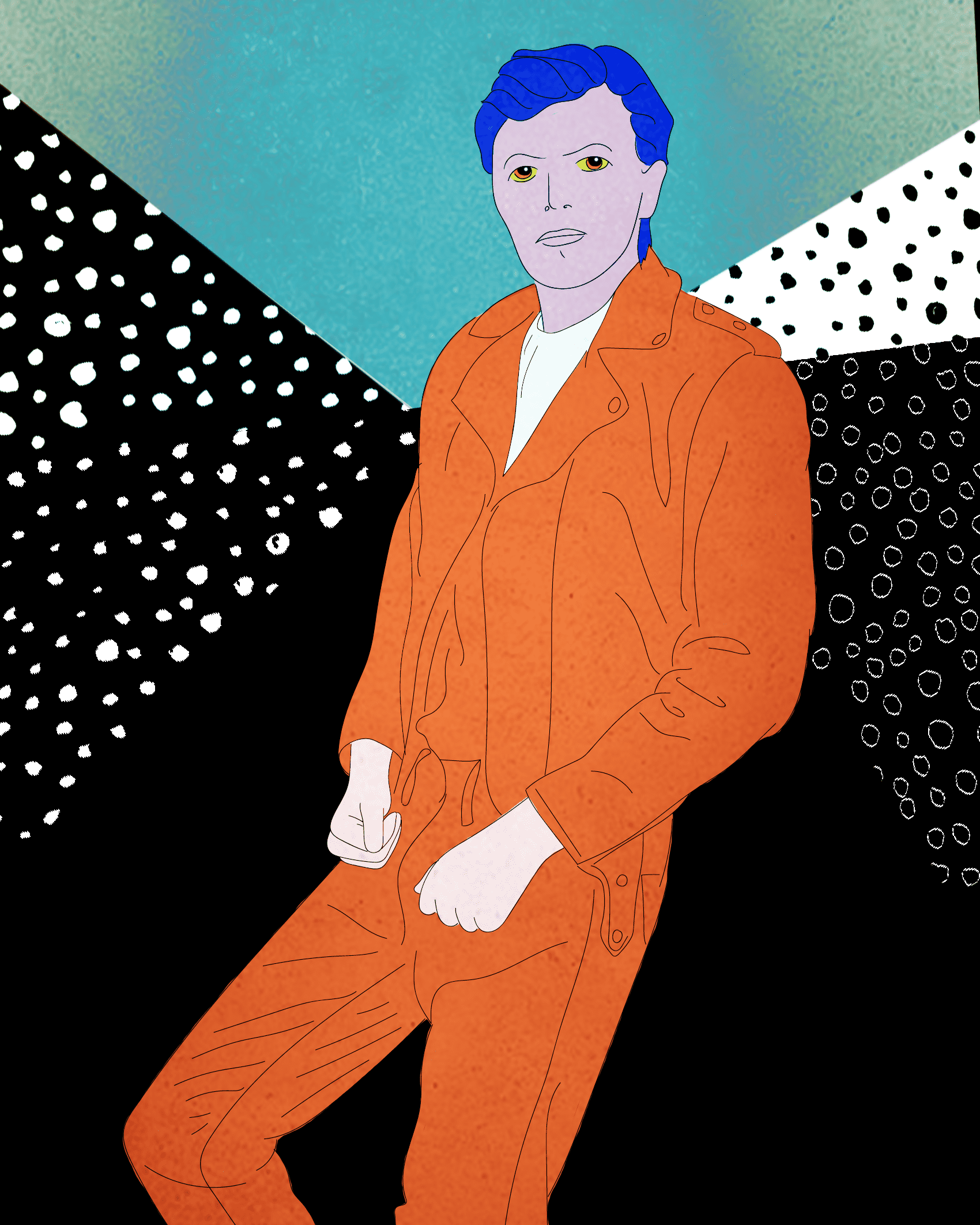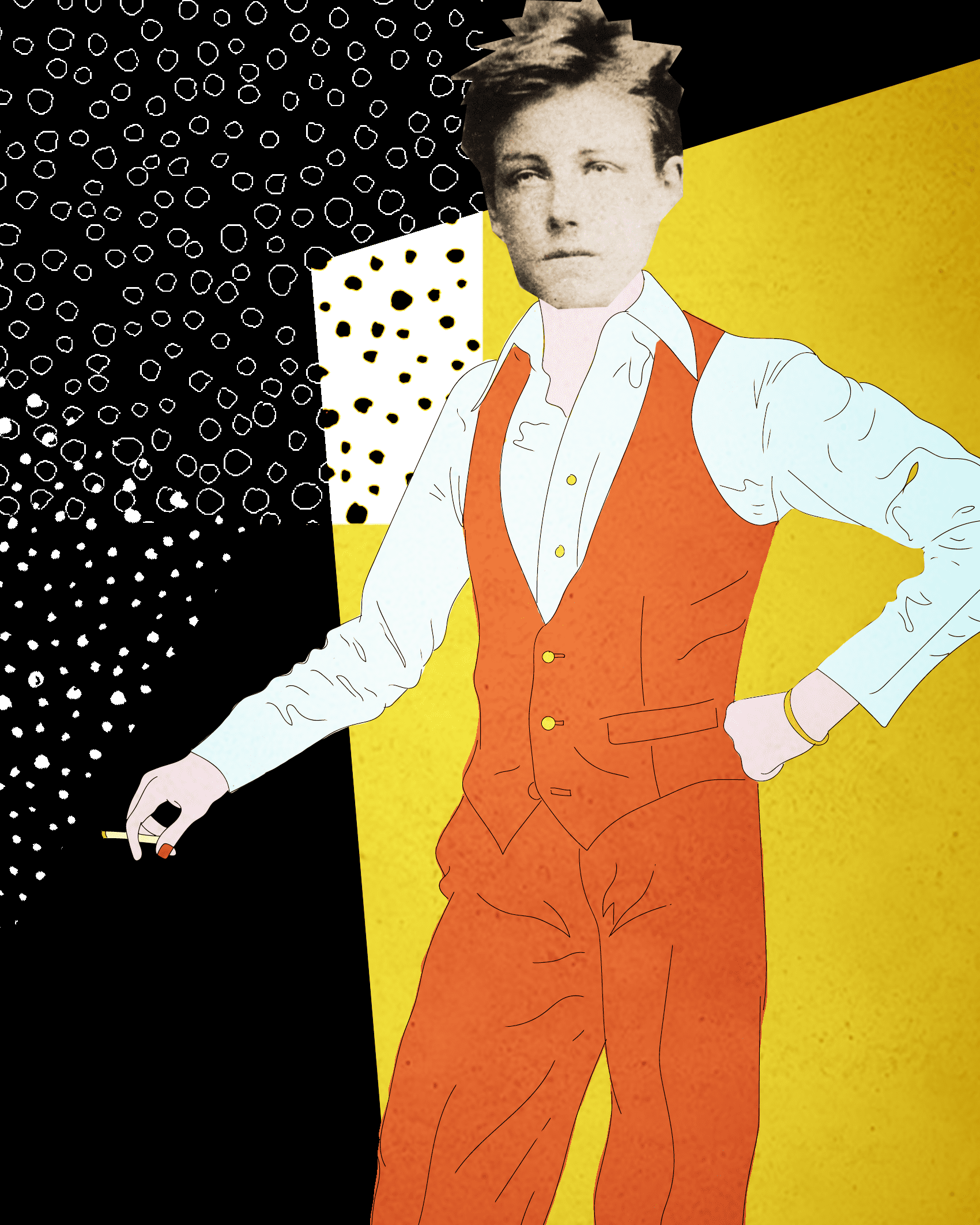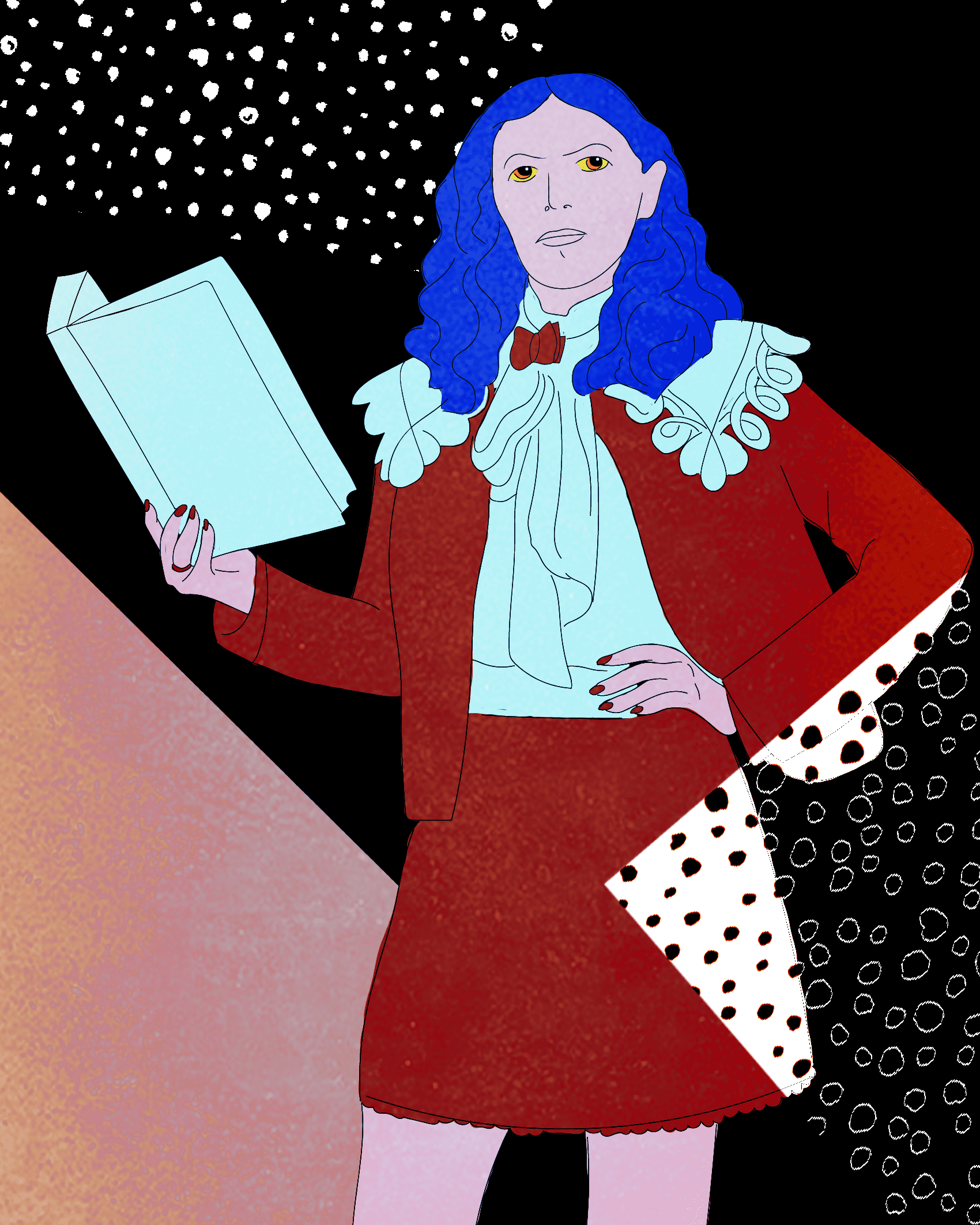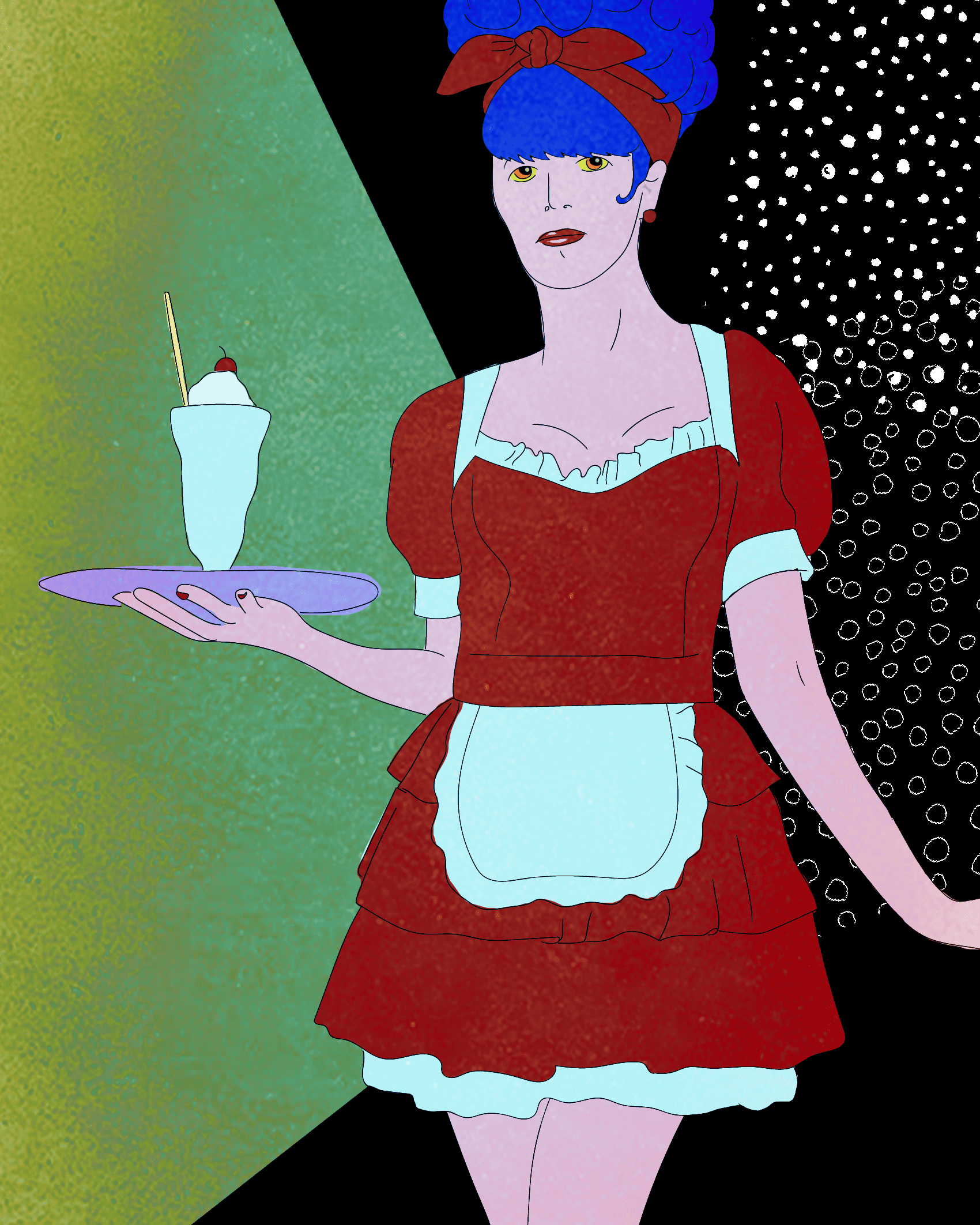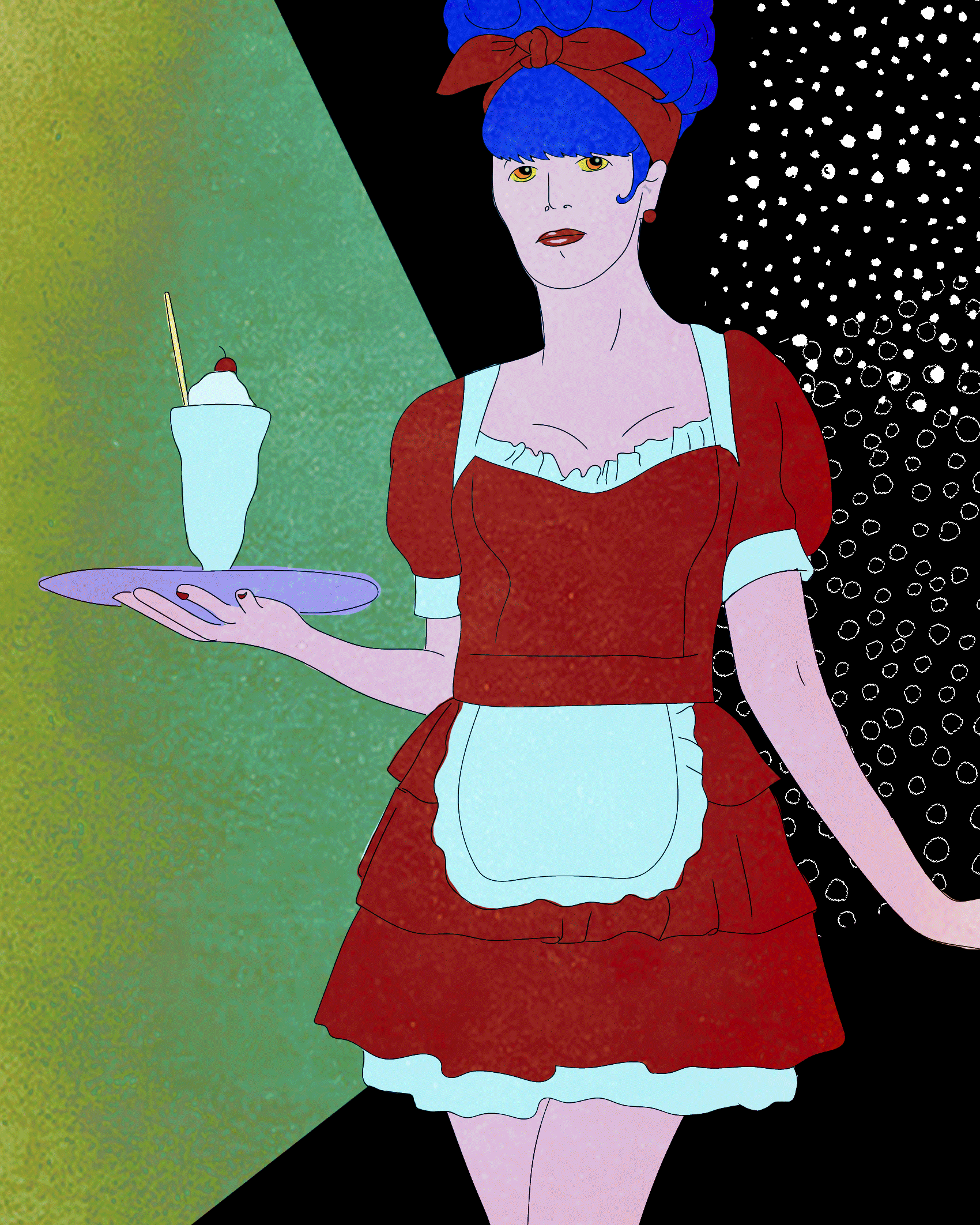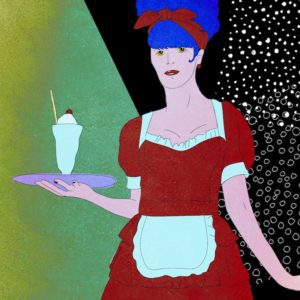
There’s a photograph of me at nineteen dressed as a diner waitress—acrylic nails, red pumps, apron tied around a red checkered dress. I’m standing in my college living room just before the school’s annual drag party, hands on hips, eyes pointed toward the ceiling, trying to channel Tom Waits’s femme fatale in “Invitation to the Blues.” I have a beehive wig and scarlet lips that make me look a little “like Rita Hayworth / At the counter of the Schwab’s drug store.” I hold a pad of order paper on which I’d scrawled, “Over medium or scrambled?” But while Tom Waits’s waitress poured coffee somewhere in the rural heartland, when my character spoke she brought every bit of the New York accent in me to the fore.
Tall with teased hair and a nasal cadence, Barb loved to chat with my bubbly Midwestern mother and update us on her teenage son. She wrote down my parents’ orders—maybe cottage cheese one Sunday, eggs Benedict another, orange juice or hot chocolate—her coral nails tapping against the order pad as she wrote. She never took mine, though, because I always ordered the same thing: eggs over medium, home fries, white toast. “Want your usual?” she’d ask, and I’d nod enthusiastically until, noticing a glance from my mother, I remembered to shyly mumble, “Yes, please.”
I loved having a usual because it meant that Barb saw me, that in the short-order world of The Red Fox, I belonged. At school, kids taunted me, sneering, “Are you a lesbian?” It was the only pain-inflicting word they knew to describe a girl who refused to cultivate femininity, who was too opinionated, and who once asked her entire gym class to call her “Dean”—the masculine version of her given name—a request that was laughed at and ignored by everyone including the teacher. Even at Our Lady of Mt. Carmel I worried about my school bully sitting behind me, or staring at me from the pews as I lit candles and carried the Bible for the priest while trying not to trip on my altar server robes. When she was there, I counted down the minutes until Mass was over and tried to slip out of church as quickly as possible, pestering my parents to hurry up. Only when we walked through The Red Fox’s double doors was I at ease.
After our orders were in, I walked along the diner’s Formica counter and imagined sitting there, sipping the coffee I was not yet allowed to drink. It wafted out of cups and off the stained counter; it smelled good, like acrid earth and boyhood. I imagined I was Danny Zuko in Grease, or Robin Hood in the animated film my elementary school showed whenever recess rained out. A tough kid sidling up to the counter and ordering a cup of joe. Someday, I thought, reaching the end of the bar and pushing open the porthole doors that separated the dining room from the restrooms. I selected: Ladies.
“Like most children, I once thought it possible to divide the world into male and female columns,” writes Bernard Cooper in “Burl’s,” an essay named after the 1950s greasy spoon his family frequented during his childhood. “Blue/Pink. Roosters/Hens. Trousers/Skirts. Such divisions were easy, not to mention comforting, for they simplified matter into compatible pairs.” Sent out from the restaurant one evening to grab a newspaper for his father, eight-year-old Cooper sees two women, who he reads as transgender, walking down the street. Cooper, who now identifies as gay, is irrevocably shaped by this encounter. It destabilizes his young world and leaves him lying in bed at night wondering if gender is not the rigid binary he was raised to believe in—if it is, in fact, more expansive and complex than he previously could have imagined.
“But there also existed a vast range of things that didn’t fit neatly into either camp,” Cooper continues, “Clocks, milk, telephones, grass.” I wouldn’t have been able to articulate it at the time, but I felt like that when I was young. Like I was made of clocks and milk, telephones and grass—in-between objects composing an in-between child.
Fox (verb): to trick or fool (someone): to confuse (oneself).
The Red Fox, The Mont Olympus, The Seven Brothers, The Star—those Westchester, New York diners had names drawn from the books of fairy tales and Greek mythology I checked out from the Greenburgh Public Library and spent weekends pouring over. Their novel-length menus, cases of colorful pies, and bright neon signs added to my sense that diners were ever-so-slightly enchanted—a little more like Narnia or the tangled forests of the Brothers Grimm than church, the playground, or the bagel shop down the street. I knew that fantastic places were transformative, that when characters fell down a rabbit hole or boarded the Hogwarts Express they became someone else on the other side. As I sipped hot chocolate and later coffee in those mirrored dining rooms, I imagined myself as a character in one of those stories, and found that the veil between who I was and who I could be thinned.
At History Keeps Me Awake at Night, the Whitney’s 2018 David Wojnarowicz retrospective, I wandered through photographs from the activist-artist’s “Arthur Rimbaud in New York” photo series, in which he had friends pose in a cardboard mask printed with a photograph of the long-dead writer. I passed Rimbaud on the subway and beneath a pier before I stumbled across an image I hadn’t seen before. In it, the eighteenth-century French poet sits in a 1970s diner. His booth is nestled to the left of a rotating pie case, and the table is scattered with an empty coffee cup, a milk creamer, and a plate of what looks like hash browns and eggs. Rimbaud wears a t-shirt and sleeveless vest, and holds a tiny muffin like a delicate tea cup.
Throughout high school, each Sunday evening, after my friends and I attended a nontheistic-and-pretty-punk-rock youth group, we’d head to the Mont Olympus diner. We crowded four to a backseat in hand-me-down cars, cranked up hot jams or Against Me! and drove—often too fast—down Yonkers’s Central Avenue. Just past the Pizza Beat and Enterprise Rent-A-Car, the hilltop diner’s chrome carapace came into view. Once inside, we were ushered into a back room away from the other customers, where we ordered cheesy fries, muffins, or soup crackers, which the diner sold us for fifty cents apiece.
My favorite nights were when a crew of older boys—graduates of the youth group—stopped by to see their siblings or friends who were still in high school. Those boys studied art or creative writing at the nearby state college or in the city; they smelled like the American Spirits and Olde English they bought at bodegas that rarely carded. They were beautiful in an unwashed and unslept kind of way; they read Kurt Vonnegut and French poetry. I had crushes on them, sure, but mostly I wanted to be like them: to possess their easy way of quoting Mallarmé and Rimbaud, their perfect bohemian postures.
I took up smoking. I bought a copy of Rimbaud’s collected poems and loved “Novel” best of all. I wanted my wild heart to move through novels like Robinson Crusoe. I studied that famous photograph of teenage Rimbaud, the one with the almost comically graven gaze. “No one’s serious at seventeen,” I said to myself over and over as I looked in the mirror, and if I did it long and hard enough, I could almost see his messy cropped hair instead of my straightened bob, an unraveled necktie in place of my chunky costume jewelry. I bought notebooks and promised myself I would scribble down every line of poetry that popped into my head, but when I sat down to write, my pencil trembled like a small insect on the page, leaving a trail of broken lead behind it.1
“Rimbaud is a surrealist in the way he lived, and elsewhere,” Andre Breton wrote in his 1924 Surrealist Manifesto. Out of the twenty-one proto-surrealists Breton listed, only one—writer Marceline Desbordes-Valmore—was a woman.
Outwardly I emulated the arthouse girls who had those boys on their arms—girls who were too cool to come to youth group, who some of my friends called “the blow job crew,” a slut-shaming, mean-spirited moniker that I—regretfully—delighted in. I wore thrift store dresses, dyed my hair bright red, and practiced my poise. But I also cried too much, picked fights with friends, and barely slept. Sometimes I put cigarettes out on my clothes because the small cauterized holes made me feel tough and a little crazy. Instead of sauntering at the edge of the crowd during punk shows like those girls did, I jumped into mosh pits until my whole body felt bruised and alive.
There are things I didn’t know then. That when I was three years old—before my family moved from Maryland to New York—an artist named David Wojnarowicz died. That his death was not so much the result of an uncontrollable disease as the willful inaction of a conservative government and its cronies. That we both attended Catholic school, and that Wojnarowicz spent the end of his life scream-writing against Cardinal John O’Connor and the Archdiocese of New York—the same diocese to which my family belonged.
Nearly three decades later, I read from Wojnarowicz’s essay “Postcards from America: X-Rays from Hell” in front of an audience. We were both included in the same anthology, and when my co-readers and I decided to pick one other piece from the book to share with the crowd, Wojnarowicz’s was my only possible choice. I, genderqueer but not a gay man; I, who hadn’t lived through the AIDS crisis, was so grateful and thankful and proud of this man who stood up against the house of power I had been raised inside.
“Shut down our clinics and we will shut down your ‘church’,” I scream-read, “This creep in black skirts has kept safer sex information off the local television stations and mass transit spaces for the last eight years of the AIDS epidemic thereby helping thousands and thousands to their unnecessary deaths.”
“—Then cavatinas die on your lips.” – Arthur Rimbaud, “Novel”
Besides “Novel,” I didn’t like Rimbaud’s poetry that much—A Season in Hell was fine, but I was more interested in Gabriel García Marquez and Cindy Crabb’s Doris Zine. Rimbaud was really a metonym to me: for “boy,” for “writer,” for “rule breaker.”
Within a few years I would see that those diner boys got lost in booze and poetry as a way to disengage with the world. That Rimbaud, too, left a bourgeois family in the provinces for Paris, then left Paris to become a weapons dealer in Ethiopia. That he never stood on a picket line or planted a community garden or used his voice to scream and scream and scream for life in the face of politicized death. But then? Then they were symbols, all of them, of a self I longed for, but feared I could never become.
Sometimes one of those boys ordered toasted ravioli and when the heaping plate arrived tableside—before the pasta was dunked in marinara sauce and devoured—they dared us to punch our knuckles into the deep-fried dumplings. One of us inevitably would, and when the small burn scars were left on my fingers, they felt like badges of honor.
“By retaining the counter, even in a truncated form, proprietors preserved a male domain within the diner.” – Andrew Hurley, “Hash House to Family Restaurant: The Transformation of the Diner and Post World War II Consumer Culture,” Journal of American History
From my perch at The Star’s long chrome counter, I nursed a cup of coffee and watched the night cook fry bacon and toss onions onto the sizzling flat top griddle. It was odd to be at The Star alone. I was usually there before punk shows held at a venue around the corner, hanging out while my boyfriend Adam’s band made set lists, or with Ryan, who took photographs and whose romantic interest I spurned, although we later led a feminist discussion group together, or Sebastían, Mara, and Liz—my core group of friends—planning benefit shows or zines or trading stories about our crushes. But I’d just gotten off the train from the city, and I wanted some time to think before heading back to my parents’ too-clean, too-orderly, and too-quiet house.
After I placed my order, I bent down and grabbed Orlando out of my book bag. It was one of two Virginia Woolf books I’d read, and the only one I’d read on my own—Mrs. Dalloway had been assigned in my junior year English class. “Mrs. Dalloway said she would buy the flowers herself,” was my favorite first line but this bit from the middle of Orlando was better:
In every human being a vacillation from one sex to the other takes place, and often it is only the clothes that keep the male and female likeness, while underneath the sex is the very opposite of what it is above. Of the complications and confusions which thus result every one has had experience; but here we leave the general question and note only the odd effect it had in the particular case of Orlando herself.
When I re-read Orlando recently I found it, like so many books I encountered in English class, marred by Woolf’s casual racism and disturbing colonialist attitudes. But back then—raised in schools and communities comprised of many cultural and class backgrounds but still educated within an overwhelmingly white, well-off, bigoted canon—Orlando was the only model of a genderqueer character in literature available to me.
I was amazed that, in the span of three hundred and twenty nine pages, the character could contain so many selves, transforming from a handsome page at Queen Elizabeth’s court to the 1930s wife of a femme sea captain, with diplomat, aspiring poet, and shepherdess tucked in between. In the book, Orlando is always “he” or “she,” never “they” (Woolf writes, “but in the future we must, for convention’s sake, say ‘her’ for ‘his’ and ‘she’ for ‘he’”). Still, I couldn’t help but see the character as a whole, both he and she, a multitude of genders, and it was uncanny how much I saw myself in that.
The night cook pulled my sandwich from the grill and slid the plate in front of me. “Thanks,” I said, putting down my book, and he nodded, a polite smile creasing his stoic mouth. I’d ordered my usual: home fries and an egg on a kaiser roll, a $2.50 carb-bomb that kept me full all night long. I squirted ketchup on the top bun then bit into the salty, eggy mess. As I ate, I wondered how many other people came into The Star daily or weekly, centering their lives around the hamburgers, muffins, and fried eggs the cook placed, with a careful and graceful masculinity, on plain white plates.
“Chop, scatter, flip, fry,” I mouthed to myself later that night, walking through White Plains’s empty streets toward the train station, as though by naming the cook’s motions I could master them. It was the summer before college, a time when people were asking me what I wanted to become. I can’t remember what I actually said, but in my head I had a ready answer: a short-order cook.
Years later, walking home at 5 a.m. after a kitchen shift or turning out egg sandwich after egg sandwich for seven bucks an hour, my arms covered in oven scars, I’d realize how difficult and underpaid the diner cook’s job likely was. But then, full of longing to be someone other than I was, his work seemed perfect.
“Crucially, the objects that move Orlando to tears are not grandiose works of art but are, instead, rather everyday objects, as if to suggest that empathy and intense rushes of affect are not triggered solely by elite art objects.” – Lucas Crawford, “Woolf’s “Einfühlung”: An Alternative Theory of Transgender Affect,” Mosaic: An Interdisciplinary Critical Journal
Replace “tears” with “transformation”, “empathy” with “identification.” Scratch out “Orlando” and put my name there. List: neon, chrome, coffee, fried eggs, spatulas, sugar packets, dinner knives crusted with butter and jam, The Coffee News, soda case, pie case, jukeboxes, mirrored walls, toaster muffins, aprons, order pads, milk pitchers, syrup pitchers, silver dollars, the smell of soup and bleach and grease and all those good things frying.
I moved south a couple years after high school, trading diner home fries for cornbread and soup beans. I lost touch with many of my New York friends, taking up with hard-edged environmental activists and rural back-to-the-landers instead. I woke at dawn to make a giant pot of coffee for the twenty-person community I lived in, and learned to identify plants, separating what had once been a blur of green into yarrow, nettles, chickweed, and burdock. I rode in the bed of a pickup truck to Idapalooza, a queer festival held in the firefly-studded woods of East Tennessee, and spent most of my time in the kitchen, prepping green beans and onions under the supervision of food writer and Radical Faerie, Sandor Katz. And one damp February in New Orleans, living off gas station po’ boys and dumpster-sourced beignets, I changed my pronouns from “she” to “they.” The shift felt less like coming home than slipping into an enchanted wood or through a magic door, finding myself in a strange and miraculous elsewhere.
“Burl’s would have been perfect, like boys and girls spliced together,” Cooper wrote in 1994, before the words I now have to describe myself—genderqueer, non-binary—came into common parlance. Reading the essay today, it’s clear that Cooper was trying to find a word for genders that didn’t fit into the “blue/pink” world he was raised in, and he ultimately settled on the name of the restaurant that catalyzed one of his earliest queer experiences.
“They finally tore down The Red Fox. But they left the sign!” my mother texted me in 2017, six years after that New Orleans winter. I hadn’t stepped foot in the diner since high school and, at some point since my last visit, a kitchen fire started and spread, damaging the restaurant and forcing it to close.
I looked up The Red Fox online. A website called Diner Hunter said simply, “The Red Fox Diner Restaurant is no longer with us.” On Weird & Wonderful America, someone named Richard wrote in 2014: “I’m sure the abandoned Red Fox Diner Restaurant in Elmsford, New York won’t be around for much longer. The building is in a terrible state of repair. But, oh, that glorious sign! I wish there was some way that would be preserved.” The post included a photo of the entrance: one of the front doors boarded up, the other spiraled with cracked glass. A posted sign read: DANGER: THE BUILDING IS UNSAFE: NO ONE IS TO ENTER.
I imagined ignoring the sign on the door and pushing through, stepping into the small dining room. Inside, I wouldn’t just find peeling booths, the coffee-stained counter, and chrome molding hanging down in disarray, but also a child unsure of whether they were a boy or a girl or neither, who was teased and called names and liked sitting in that diner with buttered toast and fried eggs best of all.
The Rimbaud mask itself was on display at History Keeps Me Awake at Night, and I paused in front of the glass case that held it. Thirteen years before, I would have longed to slip that flimsy cardboard face over my own, to disappear inside it. But that afternoon, I just stared through the mask’s pinhole eyes and pictured Rimbaud—or one of the diner boys, I wasn’t entirely sure who—peering back at me.
I wanted to believe that I didn’t care what those eyes saw and how they would categorize my gender, but, in reality, I did. I braced myself, gave the mask my toughest gaze, stood still so it could get a good look at the twenty-nine-year-old in a black t-shirt dress, with closely cropped hair and arms criss-crossed with the faintest oven scars.
***
Rumpus original art by Lauren Friedlander.
***
1. This paragraph uses language adapted from Arthur Rimbaud’s poem “Novel,” drawing from translations by both Wyatt Mason and Wallace Fowlie.↩

